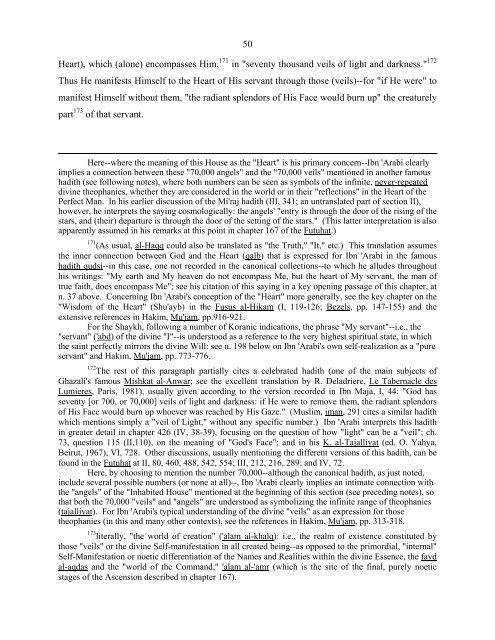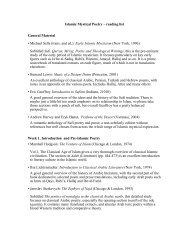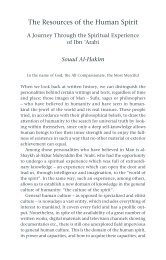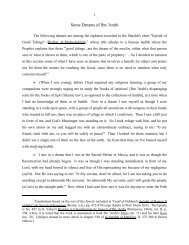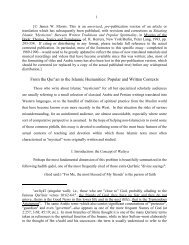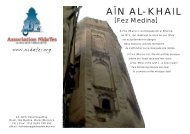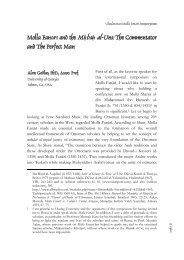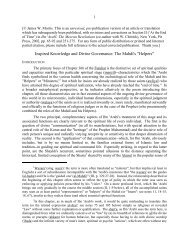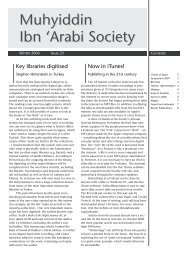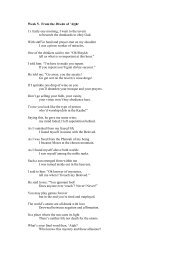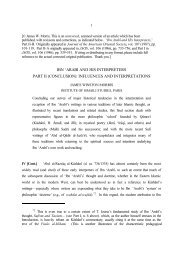'Arabî and the Mi'râj - Muhyiddin Ibn Arabi Society
'Arabî and the Mi'râj - Muhyiddin Ibn Arabi Society
'Arabî and the Mi'râj - Muhyiddin Ibn Arabi Society
Create successful ePaper yourself
Turn your PDF publications into a flip-book with our unique Google optimized e-Paper software.
50Heart), which (alone) encompasses Him, 171 in "seventy thous<strong>and</strong> veils of light <strong>and</strong> darkness." 172Thus He manifests Himself to <strong>the</strong> Heart of His servant through those (veils)--for "if He were" tomanifest Himself without <strong>the</strong>m, "<strong>the</strong> radiant splendors of His Face would burn up" <strong>the</strong> creaturelypart 173 of that servant.Here--where <strong>the</strong> meaning of this House as <strong>the</strong> "Heart" is his primary concern--<strong>Ibn</strong> '<strong>Arabi</strong> clearlyimplies a connection between <strong>the</strong>se "70,000 angels" <strong>and</strong> <strong>the</strong> "70,000 veils" mentioned in ano<strong>the</strong>r famoushadith (see following notes), where both numbers can be seen as symbols of <strong>the</strong> infinite, never-repeateddivine <strong>the</strong>ophanies, whe<strong>the</strong>r <strong>the</strong>y are considered in <strong>the</strong> world or in <strong>the</strong>ir "reflections" in <strong>the</strong> Heart of <strong>the</strong>Perfect Man. In his earlier discussion of <strong>the</strong> Mi'raj hadith (III, 341; an untranslated part of section II),however, he interprets <strong>the</strong> saying cosmologically: <strong>the</strong> angels' "entry is through <strong>the</strong> door of <strong>the</strong> rising of <strong>the</strong>stars, <strong>and</strong> (<strong>the</strong>ir) departure is through <strong>the</strong> door of <strong>the</strong> setting of <strong>the</strong> stars." (This latter interpretation is alsoapparently assumed in his remarks at this point in chapter 167 of <strong>the</strong> Futuhat.)171 (As usual, al-Haqq could also be translated as "<strong>the</strong> Truth," "It," etc.) This translation assumes<strong>the</strong> inner connection between God <strong>and</strong> <strong>the</strong> Heart (qalb) that is expressed for <strong>Ibn</strong> '<strong>Arabi</strong> in <strong>the</strong> famoushadith qudsi--in this case, one not recorded in <strong>the</strong> canonical collections--to which he alludes throughouthis writings: "My earth <strong>and</strong> My heaven do not encompass Me, but <strong>the</strong> heart of My servant, <strong>the</strong> man oftrue faith, does encompass Me"; see his citation of this saying in a key opening passage of this chapter, atn. 37 above. Concerning <strong>Ibn</strong> '<strong>Arabi</strong>'s conception of <strong>the</strong> "Heart" more generally, see <strong>the</strong> key chapter on <strong>the</strong>"Wisdom of <strong>the</strong> Heart" (Shu'ayb) in <strong>the</strong> Fusus al-Hikam (I, 119-126; Bezels, pp. 147-155) <strong>and</strong> <strong>the</strong>extensive references in Hakim, Mu'jam, pp.916-921.For <strong>the</strong> Shaykh, following a number of Koranic indications, <strong>the</strong> phrase "My servant"--i.e., <strong>the</strong>"servant" ('abd) of <strong>the</strong> divine "I"--is understood as a reference to <strong>the</strong> very highest spiritual state, in which<strong>the</strong> saint perfectly mirrors <strong>the</strong> divine Will: see n. 198 below on <strong>Ibn</strong> '<strong>Arabi</strong>'s own self-realization as a "pureservant" <strong>and</strong> Hakim, Mu'jam, pp. 773-776.172 The rest of this paragraph partially cites a celebrated hadith (one of <strong>the</strong> main subjects ofGhazali's famous Mishkat al-Anwar; see <strong>the</strong> excellent translation by R. Deladriere, Le Tabernacle desLumieres, Paris, 1981), usually given according to <strong>the</strong> version recorded in <strong>Ibn</strong> Maja, I, 44: "God hasseventy [or 700, or 70,000] veils of light <strong>and</strong> darkness: if He were to remove <strong>the</strong>m, <strong>the</strong> radiant splendorsof His Face would burn up whoever was reached by His Gaze." (Muslim, iman, 291 cites a similar hadithwhich mentions simply a "veil of Light," without any specific number.) <strong>Ibn</strong> '<strong>Arabi</strong> interprets this hadithin greater detail in chapter 426 (IV, 38-39), focusing on <strong>the</strong> question of how "light" can be a "veil"; ch.73, question 115 (II,110), on <strong>the</strong> meaning of "God's Face"; <strong>and</strong> in his K. al-Tajalliyat (ed. O. Yahya,Beirut, 1967), VI, 728. O<strong>the</strong>r discussions, usually mentioning <strong>the</strong> different versions of this hadith, can befound in <strong>the</strong> Futuhat at II, 80, 460, 488, 542, 554; III, 212, 216, 289; <strong>and</strong> IV, 72.Here, by choosing to mention <strong>the</strong> number 70,000--although <strong>the</strong> canonical hadith, as just noted,include several possible numbers (or none at all)--, <strong>Ibn</strong> '<strong>Arabi</strong> clearly implies an intimate connection with<strong>the</strong> "angels" of <strong>the</strong> "Inhabited House" mentioned at <strong>the</strong> beginning of this section (see preceding notes), sothat both <strong>the</strong> 70,000 "veils" <strong>and</strong> "angels" are understood as symbolizing <strong>the</strong> infinite range of <strong>the</strong>ophanies(tajalliyat). For <strong>Ibn</strong> '<strong>Arabi</strong>'s typical underst<strong>and</strong>ing of <strong>the</strong> divine "veils" as an expression for those<strong>the</strong>ophanies (in this <strong>and</strong> many o<strong>the</strong>r contexts), see <strong>the</strong> references in Hakim, Mu'jam, pp. 313-318.173 literally, "<strong>the</strong> world of creation" ('alam al-khalq): i.e., <strong>the</strong> realm of existence constituted bythose "veils" or <strong>the</strong> divine Self-manifestation in all created being--as opposed to <strong>the</strong> primordial, "internal"Self-Manifestation or noetic differentiation of <strong>the</strong> Names <strong>and</strong> Realities within <strong>the</strong> divine Essence, <strong>the</strong> faydal-aqdas <strong>and</strong> <strong>the</strong> "world of <strong>the</strong> Comm<strong>and</strong>," 'alam al-'amr (which is <strong>the</strong> site of <strong>the</strong> final, purely noeticstages of <strong>the</strong> Ascension described in chapter 167).


